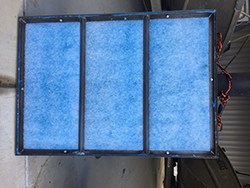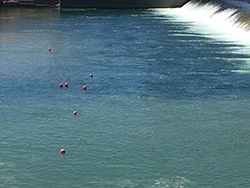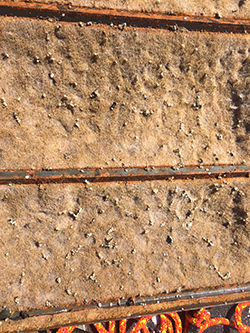
A new egg mat prior to deployment (CDFW photo by Marc Beccio)

Sturgeon egg mats deployed in a local waterway (CDFW photo by Marc Beccio)

Egg mats with Green Sturgeon eggs (CDFW photo by Marc Beccio)
CDFW biologists have been taking a new approach to looking at reproduction in one of the oldest fish species in existence.
Green sturgeon, which are listed as threatened under the Federal Endangered Species Act, are in effect a living fossil, having swam in both the fresh and ocean waters from California to Alaska for more than 200 million years.
They are a very slow-growing fish, typically living 60 to 70 years and reaching lengths of seven feet and weights of up to 350 pounds. Little is known about where they spawn in the Central Valley and how successful they are when they spawn.
In the spring of 2017, CDFW biologists began deploying egg mats in various rivers in the Sacramento Valley. In 2018, they documented green sturgeon spawning in the Yuba River for the first time, finding approximately 270 green sturgeon eggs on an egg mat deployed immediately below Daguerre Point Dam in Yuba County.
The egg mats consist of 3.5-foot by 2.5-foot metal frames that weigh about 20 pounds and are filled with a material similar to that used for a furnace filter. Mats are deployed by being gradually lowered to the river bottom from the bow of a boat. They are then retrieved by slowly hauling in the float line to avoid dislodging eggs stuck on the mat.
Unlike salmon and trout which dig redds and cover their eggs with gravel, green sturgeon females “broadcast” (release) their eggs into the water, which then sink to the river bottom, where their sticky surfaces adhere to various objects. Of eight egg mats deployed in the pool below Daguerre Point Dam, the biologists collected 270 eggs from just a single mat. As spawning locations can be difficult to identify, and eggs can be distributed broadly by the current within individual locations, documenting this spawning event was important.
A subsample of 33 eggs was retained to determine the developmental stage which will be used to calculate a spawning date. The mat was then lowered back to the river bottom. The 33 eggs collected represent about 0.02 percent of the total produced by a female green sturgeon of average size.
After confirming the presence of adult green sturgeon in the Yuba River, CDFW biologists believe the river may be important habitat for the species. Further research using these egg mats over the next several years will help fisheries managers identify critical spawning locations and habitat requirements for the future protection and enhancement of the species.
CDFW Photos. Top Photo: Green Sturgeon underwater. CDFW photo by Mike Healey.
###
Media Contact:
Kyle Orr, CDFW Communications, (916) 322-8958